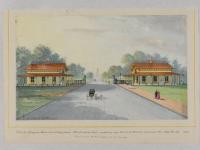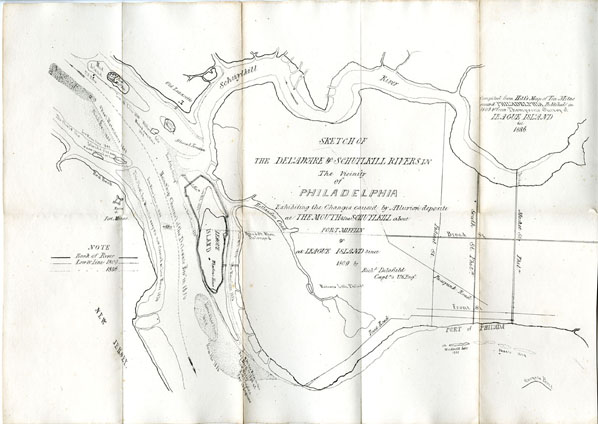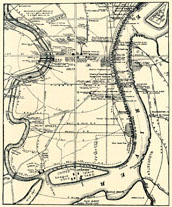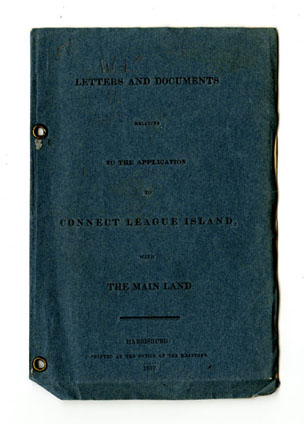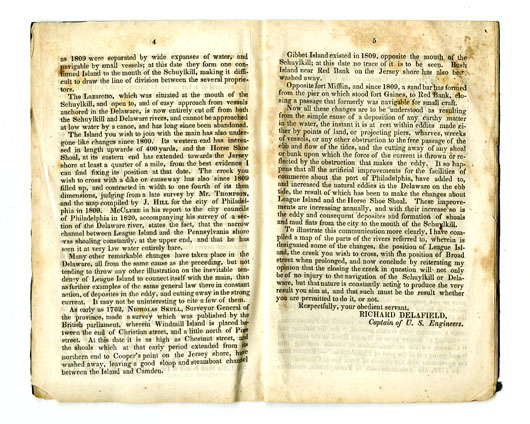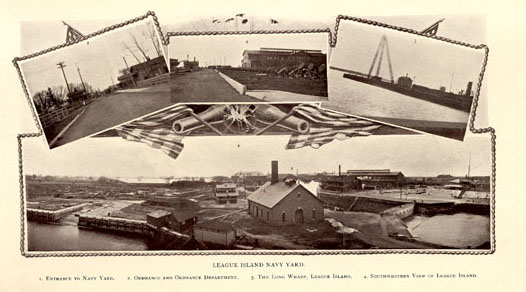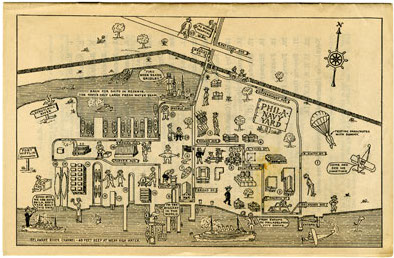When William Penn established Philadelphia in 1682, he and his settlers no doubt sailed around several islands in the southern part of the Delaware River. Today a few islands still exist in this region, such as Petty's Island and Pea Patch Island, the site of Fort Delaware. But this expansive waterway between southern Pennsylvania and southern New Jersey also once included several islands where the Delaware and Schuylkill River met – Mud Island, Little Mud Island, Hog Island, and League Island. Located just off League Island were once sandbars known as the Horseshoe Shoals.
The landscape of the Delaware River has certainly changed over time. Its ebb and flow has washed away some landmasses, such as small islands called Gibbet and Bush, while creating others. The shorelines of both New Jersey and Pennsylvania have been affected as well. Two former islands, Carpenter's and Province, naturally evolved into the mainland. But some of the change was promoted and produced by man. Mud and Hog islands were eventually backfilled, Mud Island being the home of Fort Mifflin and Hog Island now the site of the Philadelphia International Airport. League Island is now the site of the Navy Yard, but it wasn't always the Navy Yard. Its transformation from island to industry occurred in the early 1830s.
While doing some research in HSP's collections, I came across a fascinating booklet attesting to League Island's (and Philadelphia's other islands) interesting history: Letters and Documents relative to the Application to Connect League Island with the Main Land (1837). It contains transcribed and printed letters between Charles Wharton Jr. and Richard Delafield, Captain of U. S. Engineers, and others, concerning Wharton's desire to build a causeway to connect League Island to Philadelphia at Broad Street, which, back then, terminated at the Delaware River.
Wharton was a businessman with interests in the iron industry, so why did he care to have League Island connected to Philadelphia? In one of his letters he stated he would "build piers on the south side of League Island, at the termination of Broad Street, for the particular accommodation of the coal and western trade of the state." (6 January, 1837, p. 6). He was very concerned about how the piers, as well as direct connection from mainland to island would affect shipping and navigation, and he wrote to Delafield for advice. Delafield offered wonderfully detailed letters to Wharton about the history of the river and its islands and noted several acts that would allow Wharton erect a causeway and piers. By 1837, there was very little water separating League Island from Philadelphia since the "narrow channel," Delafield noted, "was shoaling constantly." (20 December 1836, p. 4). Delafield supported Wharton's plans, as did Navy Commodore Charles Stewart, to whom Wharton also wrote. Stewart eagerly supported the causeway, noting "it may finally prove beneficial to that of the Schuylkill," and that the piers and wharves would help shippers secure "commerce from ice in the winter" and would accommodate "vessels with a good harbor in all violent north and easterly gales." (7 January 1837, p. 10). The state eventually approved Wharton's plan, and so began League Island's industrialization.
League Island's history changed once again in the 1860s when the U. S. Navy, which had been based in a yard on Front Street of the Delaware, sought new land for a new yard. According to the booklet League Island Navy Yard: Its advantages as a naval station, dock-yards and shelter for the United States Navy, League Island was chosen as one of the possible sites, and was accepted by the Navy in 1868. A few years later, in 1871, the new Navy Yard was erected. The eastern portion of the small channel that still separated the island from the mainland was eventually filled in order to make room for a new airfield, Mustin Field, while a western portion of the channel was kept as a reserve basin for ships. Views of the yard, even with the coming and going of two world wars, remained largely unchanged until the 1960s. The construction of a new interstate highway, I-95, forever changed the site of southern Philadelphia on the Delaware.
The U. S. Navy ceased operations at the yard in the mid 1990s, and by 2000, the land was once again owned by the city of Philadelphia. Today, gatekeepers at the Navy Yard continue to salute the patrons that enter the yard, no matter if they're heading to the Tasty Baking Company, Urban Outfitters, GlaxoSmithKline, or another of the many business that currently reside there.

